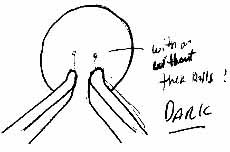




 Associative
Remote Viewing can be applied by a single individual or in a group
environment. A
recent public example of an individual successfully applying ARV was discussed by Greg Kolodziejzyk at
the Year 2000 RV Conference. Here is an excerpt from
his abstract of Predicting
the Future with ARV:
Associative
Remote Viewing can be applied by a single individual or in a group
environment. A
recent public example of an individual successfully applying ARV was discussed by Greg Kolodziejzyk at
the Year 2000 RV Conference. Here is an excerpt from
his abstract of Predicting
the Future with ARV:
As part of his on-going research, Greg has used this mental technique for two years to predict the outcome of various random financial
markets. Turning an initial trading account of $15,000 into over $70,000 stands as an incredible public testament to his methods, and to
the power of conscious thought.
For more info see Greg's Website.
A successful group ARV approach was reported in a 1995 Journal of Scientific
Exploration paper by Russell Targ, Jane Katra, Dean Brown and Wenden Wiegand, Viewing the Future: A Pilot Study with an Error-Detecting
Protocol. The full abstract follows:
This paper describes a precognition experiment in which two researchers took the part of viewers, and worked with two judges to
design and implement an experiment in associative remote viewing. We used a redundant protocol to eliminate some of the problems
experienced by many of us who have tried to harness psi for real world applications. We carried out nine weeks of remote viewing
trials, in which the viewer was to describe the target that he or she would be shown two days in the future. At each trial the viewers
had their own target pools of two targets about which they knew nothing. A total of 18 viewings were carried out at the rate of one per
person per week. Targets were randomly assigned "up" or "down" status by the judges previous to the viewing. If the viewers both
accurately described targets of discrepant directions, then the trial was considered a pass. Additionally, if a viewer's target
description failed to be awarded a rating of 4 or more on a 0-7 point rating scale, his or her call was declared a pass. Of the 12
viewings that were not rated pass by the judges, 11 correctly described the object that the viewer was shown at a later time (p =
0.003). The objects shown to each viewer corresponded to the direction of the one-day change in the price of May Silver futures. Of
the nine trials carried out, two were passed for various reasons, and seven were recorded as traded in the market, although no
purchases were actually made. Six of the seven trade forecasts were correct.
The common ground that we see in the two ARV protocols are summarized below:
1. Both Studies Used Two (2) Possible Targets - The judging task is simplified as is the choosing of possible targets compared to protocols with 3 or more possible targets. Also, the probability of describing the wrong target very well, by chance, is reduced.
2. Both Studies Filter-Out the Poorly Rated Transcripts - The viewer's transcript was evaluated using self-judging (where the viewer judges his/her transcript) in one case and independent-judging in the other. The key may simply be that the poor sessions were ignored for making investment/prediction decisions in both cases. The poor sessions probably contained little or no precognitive information.
3. Both Studies Used a Redundancy or Concensus System - Each protocol calls for more than one session for any investment/prediction thereby permitting a "pass" or a concensus to develop.
Protocols, of course,
are only one part of a successful ARV project. The remote viewer must be
"tuned-in" to the correct future targets which means "tuned-out"
from his/her egocentric viewpoint - the ego often has great difficulty trusting precog info
from unknown sources! We would like to close with a quote from Joe McMoneagle, who is one of the best
and possibly the most public remote viewer working today. In his book,
"Remote Viewing Secrets: A Handbook",
Joe suggests several techniques for dealing with the ego in order to permit the
psychic information to be received and reported - here is one key technique that
is relevant to all ARV approaches:
Develop an attitude that success or failure is not the measure by
which you will judge your efforts. Judge your efforts on your ability to
clear your mind, center your thoughts, meet the challenge, and glean as much
from the experience as you possibly can. Don't think about being right,
think about doing the right thing, honoring the skill, and accepting whatever
you are gifted with in response. ...
Go to another section of this issue:
Physics:
"God Particle" Observed - Maybe Intuition:
Consciousness-Intention-Trust
![]()